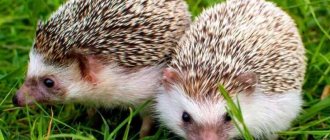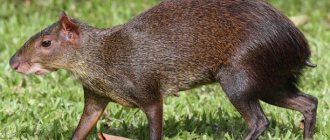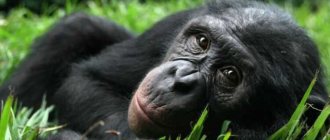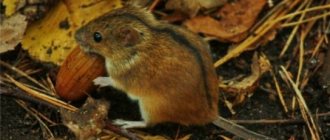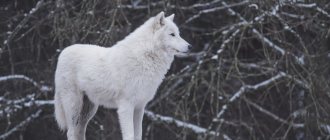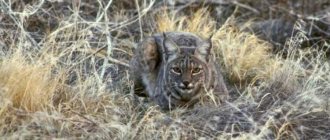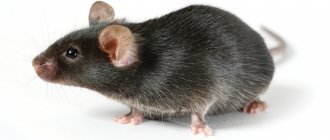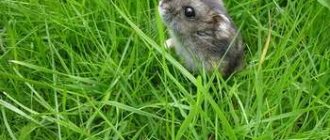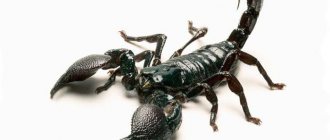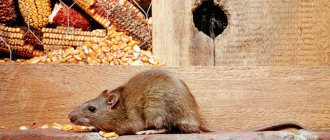Mice are nimble and small rodents, whose appearance and specific habits are known to everyone.
Most species of these funny mammals belong to the group of synanthropic animals, that is, they choose areas near human habitation as their habitat, which facilitates access to food sources and heat.
Mice are distributed throughout the entire planet, with the exception of high mountain areas and the Far North. Decorative species of animals have been bred that require home maintenance and care.
Where does the mouse live?
The distribution range of mice covers almost all climatic zones, zones and continents of the globe. Mouse representatives can be found in tropical thickets, coniferous or deciduous forests, steppes and deserts, on mountain slopes or in swampy areas. Mice also live in people's homes.
Mice can build nests from grass stems, occupy abandoned burrows, or dig complex systems of underground passages. Unlike species that live in swamps, mountain, steppe and forest mice swim poorly.
Mouse - description
These small rodents are distributed throughout the entire earth, excluding the extreme northern and high-mountain regions. The closest relatives of mice are jerboas, mole rats, hamsters and dormice. And more distantly related are rats, chinchillas, porcupines, beavers, and guinea pigs. In total, the Mouse subfamily includes 121 genera and more than 300 species.
The mouse is a small animal with an elongated and pointed muzzle, large round ears and bulging beady eyes. A long, hairless or slightly pubescent tail is a distinctive feature of the animal. The limbs, which are not the same in length, are adapted for digging and moving along vertical and horizontal surfaces. The body length of a rodent can vary from 3 to 20 cm, weight - from 15 to 50 g.
Mice have a special bite. On the lower and upper jaws the animal has 2 chisel-shaped teeth, which are continuously growing. Rodents are forced to constantly grind them down, which is why their incisors are very sharp.
Animals from the Mouse family have good eyesight and can distinguish between red and yellow shades. The usual body temperature of these rodents ranges from 37.5 to 39⁰C. The maximum lifespan of mice is 4 years.
General characteristics of mouse representatives
The large family of mice is not fully understood. On the territory of Russia there are 13 species of animals from the order of rodents, representing 5 genera. They all have a similar appearance, structure and lead almost the same lifestyle. Possessing a unique ability to adapt to any living conditions, mice thrive in all natural areas. The exceptions are the Far North and Antarctica. The widespread distribution of various species of rodents suggests the numerical dominance of their representatives among other mammals.
Interesting!
The familiar word “mouse” translated from the Indo-European language means “thief”, which is fully justified by the habits of the nimble animal.
Appearance:
- The mammal has a small elongated body. Its dimensions, depending on the species of the individual, range from 5 to 20 cm. This parameter is doubled due to the tail.
- The body of the mouse is covered with short hair, the color palette of which is gray, brown, red or brown. In nature, there are striped and variegated individuals, as well as snow-white albino rodents.
- The average weight of a mouse is 20-50 grams.
- Animals have a short neck.
- On the pointed, triangular-shaped muzzle, there are small black beady eyes and semicircular ears, providing good sound perception.
- Due to the sensitive thin whiskers - vibrissae - growing around the mouse's nose, it is able to perfectly navigate its surroundings.
- The short legs are equipped with 5 tenacious fingers, allowing them to overcome significant obstacles and dig holes.
To get acquainted with representatives of the rodent order, it is advisable to carefully study the photos of mice posted on the site.
Appearance of the mouse The animals, like other representatives of this family, have two pairs of large incisors located on the upper and lower jaws. They are very sharp and constantly grow - up to 1 mm per day, so they must be ground down. Failure to perform this procedure can lead to the death of the mouse if the length of the organs reaches 2 cm.
Rodents are highly fertile. At the age of 3 months, the female is capable of conception and childbearing. A wild mouse living in natural conditions breeds in the warm season, while animals living in heated rooms breed all year round. Pregnancy lasts approximately 20-24 days and, after this time, from 3 to 12 cubs are born.
Mice are born absolutely helpless - blind, toothless, naked. The mouse feeds it with milk for about a month. By the 10th day, the offspring are completely covered with hair, and after 3 weeks they become independent and disperse. Under favorable conditions, the population grows rapidly. The average lifespan of mice is 1-1.5 years. Genetically, they are capable of existing for 5 years, but how long the animal will live depends on specific circumstances.
On a note!
Bats do not belong to the mouse family. They are representatives of the order Chiroptera, which ranks second in size after rodents.
Types of mice
The mouse family includes 4 subfamilies, 147 genera and 701 species, the most common of which are:
- Whale shark
- 34 facts about raccoons
- Maned wolf
- Nettle
- Elk
- 100 facts about bears
- The field mouse (lat. Apodemus agrarius) reaches a size of 12.5 cm, not counting the tail, which can be up to 9 cm long. The color of the back of the mouse is gray, with a slight yellowish-brown tint and a dark stripe running along the ridge, and the belly is light gray color. The habitat of the field mouse includes Germany, Hungary, Switzerland, Poland, Bulgaria, the southern part of Western Siberia and Primorye, Mongolia, Taiwan, the Korean Peninsula and certain territories of China. This species of mice lives in wide meadows, in dense thickets of bushes, city gardens and parks, and makes a refuge both in burrows and in any natural shelters. In flooded areas it builds nests on bushes. Depending on the season, the diet may consist of seeds, berries, green parts of plants and various insects. The field mouse is the main pest of grain crops.
- The yellow-necked mouse (lat. Apodemus flavicollis) has a reddish-gray color and a light belly (sometimes with a small spot of yellow). The body size of adult individuals reaches 10-13 cm, the tail has approximately the same length. The mouse weighs about 50 grams. This type of mouse is widespread in the forests of Russia, Belarus, Moldova, Bulgaria, Ukraine, the Caucasus, the northern provinces of China and Altai. Yellow-throated mice live on open edges in hollow trees or dug holes, but they can also live in rocky areas. Their diet includes both plant and animal foods. By eating young shoots of fruit trees, they cause significant harm to nurseries.
- The grass mouse (Nilotic grass mouse) (lat. Arvicanthis niloticus) is one of the largest representatives of the mouse family and can reach 19 cm in length, and with the tail - 35 cm. The weight of individual large individuals exceeds 100 g. The fur of the back and sides has dark gray or grayish-brown in color with individual hard and spiny bristles of a darker shade. The belly color is light gray. This type of mouse is most common in African countries, where they live in bushes, forests and savannas. As a refuge, grass mice choose abandoned termite mounds or dig holes on their own, but on occasion they can enter human habitation. The basis of the diet of mice is plant food.
- The baby mouse (lat. Micromys minutus) is one of the smallest rodents in the world. The body length of an adult animal does not exceed 7 cm, the tail - 6.5 cm, and the weight of the baby does not exceed 10 g. The back and sides are plain and have a reddish-brown or brown color, in contrast to the light gray, almost white belly. The muzzle of baby mice is short and blunt, with small ears. The distribution area of this species of mice stretches from west to east from the northwestern provinces of Spain to Korea and Japan, in the south to Kazakhstan, China and the northern regions of Mongolia. The mouse lives in forest and forest-steppe zones, in meadows with tall grass. In the summer, mice use nests made in the grass as shelter, and overwinter in burrows, haystacks, and human residential or outbuildings. The basis of the diet of baby mice is the seeds of cereals and legumes, as well as small insects. They often settle near granaries, causing enormous damage to agriculture.
- The house mouse (lat. Mus musculus) is the most widespread species of the rodent family on the planet. The body length of an adult mouse does not exceed 9.5 cm, and together with the tail - 15 cm. The weight of the mouse is 12-30 g. The color of the fur on the sides and back is gray with a brown tint, and on the abdomen from light gray to white. Individuals living in desert areas are sandy in color. The mouse's muzzle is sharp with small rounded ears. The distribution range of this species of mice does not include only the territory of the Far North, Antarctica and high mountain regions. House mice live in all types of landscapes and natural areas, and very often penetrate into human outbuildings and residential buildings. In natural conditions, they dig minks on their own, although they can also occupy homes abandoned by other rodents. They feed on seeds and juicy green parts of plants, and once they enter a person’s home, they eat everything they can get their teeth into – from bread and sausages to paraffin candles.
- The striped mouse (lat. Lemniscomys striatus) is a small rodent: the length of the body is 10-15 cm, intermittent stripes of light colors are visible along the back and along the sides. Under natural conditions, striped mice rarely live more than 6-7 months; in captivity they live two to three times longer. The menu of these individuals includes mainly plant “dishes”: root vegetables, soft seeds, juicy fruits, and occasionally small insects.
- The spiny mouse (Acomys) (lat. Acomys) is a rather cute representative of the mouse family, the owner of huge eyes and equally large ears. The size of the spiny mouse, including its tail, is 13-26 cm; the back of the animal is covered with thin spines, like a regular hedgehog. An amazing feature of these animals is regeneration: when in danger, the mouse is able to shed a piece of skin, leaving the attacker bewildered. The skin is quickly restored without damage to the individual. The spiny mouse lives in Asian countries and is found in Cyprus and Africa. Its diet relies on plant foods; this animal is often kept as a pet.
Varieties
House mice live everywhere. This is facilitated by high adaptive capacity. The animals tolerate cold and heat relatively well and adapt to any living conditions. Close proximity to humans ensures survivability - a minimum of enemies, a large amount of food. A typical representative of mice can be found outdoors and indoors. Lives in garages.
House mice are the most common experimental specimens in laboratories. Over many years of work, breeders have intentionally or unintentionally bred many different subspecies of house mice. But several have been officially identified.
House mouse classification:
- musculus – has become widespread in Poland, Northern and Eastern Europe, and parts of Russia;
- bactrianus - an interesting species of domestic mice found in Asia;
- domesticus - a heat-loving species found in Southern Europe, America, Africa, Australia;
- castaneus is another representative of Asia, only in the southeastern part.
Types of mice
For a long time, there was another type of domestic mouse - Mmmolossinus. Rodents have become widespread in Japan. However, later scientists stated that this species cannot be classified as a separate type, since they obtained the animals by crossing Mmmusculus, Mmcastaneus.
How mice behave in their natural environment
In order for rodents to maintain a constant body temperature, they need to be active in winter and summer, day and night. Gluttony and fussiness for mice are characteristic traits that help them survive and leave offspring.
In the fall, animals begin collecting provisions in a burrow or on the surface of the ground, where the “warehouse” is camouflaged with earth. And if in the off-season rodents are awake at night and sleep during the day, then in winter they remain active around the clock. In spring and autumn, when there is no shortage of food and no temperature fluctuations, mice actively reproduce.
Mice live in large families, since together it is easier for them to defend themselves, get food, build homes, and raise offspring. In a mouse pack there is a leader who maintains order in the group. Female mice are peaceful. But young males do not always put up with their subordinate position. Stomping with its hind legs and aggressive tail strikes indicate the animal’s intention to conquer the “throne.” Inter-family clashes can lead to the disintegration of the pack.
Mice spend most of their time in burrows, raising offspring, escaping danger, storing food, or resting after eating it. The maximum depth of the burrow is 70 cm, and the total length of the passages can reach 20 m. Some species of mice build nests in thickets of tall grasses (little mouse) or live in tree roots and old stumps (forest mouse).
Minks can be temporary or permanent, and the latter can be summer or winter. Temporary housing for animals is simply planned. The permanent mouse hole has a spacious nesting chamber and several entrances. In summer burrows where rodents give birth, bedding is created from fluff, blades of grass, shavings and feathers. And in winter, a pantry is set up for food supplies.
Large voles?
This mouse is a rodent that is a character in folk and original fairy tales. It is voles who carry grain, live in barns and, in principle, prefer to live in close proximity to humans. The minimum body length of this animal is 7 cm. However, how large a vole mouse will grow depends on its diet. In rural barns, little mice can grow into larger animals than their counterparts born among the steppe feather grass.
A distinctive feature of this species of rodents, which distinguishes voles from all others, is the length of the tail. The proportional ratio with the body is 1:3. This species of mouse has a hamster mentality - they build pantries, constantly replenish food supplies and live in burrows with a lot of “rooms”.
Nutritional features of mice
Peering at damaged containers, furniture, household items, and walls of the room, one gets the impression that the mouse is omnivorous. It chews on everything it comes across on the go, even if it has no nutritional value.
Such a brutal appetite is explained by several aspects of her life:
- The mouse is forced to constantly grind down its front teeth. Chews hard objects.
- The animal has an accelerated metabolism. Food is quickly digested, and due to high mobility, energy is instantly consumed. On average, a rodent should eat 5 g of food and drink 20 ml of water per day.
- The mouse has this peculiarity - it tastes everything new and unknown.
Regarding food preferences, the mouse is a predator. But he prefers plant foods. Replenishment of proteins is carried out by eating worms, insects, eggs, and chicks. The herbivorous creature eats helpless birds with great appetite and steals eggs from nests. Then he arranges a home for himself in this place.
A herbivorous mouse gnaws seeds, the green part of plants. If there is a lack of fluid, he eats berries, fruits, and vegetables. Prefers grains, cereals, seeds, flour.
Reproduction in mice
The mouse is a polygamous animal. In nature, one male fertilizes from 2 to 12 females. Over 12 months, mice have from 3 to 8 litters. The female reaches sexual maturity 10 weeks after birth. At this time, she begins to go into heat, which lasts 5 days and is expressed in special behavior.
If after coating the female fails to become pregnant, a new estrus occurs within a week. If fertilization is successful, the female animal is expected to give birth in 17-24 days. There are from 3 to 9 cubs in one litter. Female mice give birth at night. Babies, when born, are unable to move, hear or see. They have no hair and their size ranges from 2 to 3 cm.
Mice develop rapidly:
- 3 days – fluff appears on the body;
- Day 5 – the cubs begin to hear;
- Day 7 – the animal’s body weight doubles;
- Day 14 – palpebral fissures appear;
- Day 19 – the mice begin to eat on their own;
- 25 days – the length of the body reaches 500 mm (the tail is 15-20 mm shorter) and the mouse is already sexually mature.
Decorative mice develop a little slower. It is recommended to mate them no more than 2-3 times a year. Repeated births exhaust the female, and each subsequent offspring becomes weaker.
A little history
In nature, white albino mice are periodically born, and it is almost impossible for them to survive, since they are very noticeable and also instantly become prey. But in ancient times in Crete they were kept in the form of living amulets that bring good luck. They were also kept in temples, where they were specially looked after by ministers. 4,000 years ago, mice were bred and kept in Ancient Egypt, paying close attention to colored species. The Egyptians attributed supernatural abilities to them, and also depicted them on their clay vessels.
During the period of Ancient Rome and in the Middle Ages, healers used mice and rats for medicinal potions, while in Asia they are still specially bred for such purposes. With the development of veterinary medicine and experimental medicine, mice and rats began to be used for various studies as laboratory animals. It is believed that decorative and laboratory mice originate from white, spotted and black fighting mice, described in a book published in 1787. It talks about the animals that were used for fighting at that time. English merchants brought them from Japan. Subsequently, the mice formed a special line of house mice, and decorative breeds began to be bred as pets.
Today, in various countries of Western Europe and America, there are Clubs for mouse lovers, the main goal of which is to breed new varieties of these animals. Most often, individuals of different colors are obtained: gray, white, red, brown, lilac or pinkish, with spots. Special exhibitions with expert assessments are held there.
But in our country, decorative mice are less known than in America and Europe, but among animal fans they are becoming more and more popular every year. In clubs for lovers of various rodents, special sections of ornamental mice have been created, nurseries have been opened that engage in selection and breeding work, and exhibitions are also held where house ornamental mice are exhibited along with other small animals.
Enemies of mice
The mouse is a key link in the food chain of many ecosystems. Many wild animals depend on the existence of this small rodent. For mice living in the forest, the main enemies are foxes, martens, arctic foxes, ferrets, stoats, weasels, lynxes and even wolves. Predators easily tear apart burrows and can eat up to 30 small animals a day.
Mice are the main food for snakes and large lizards. Reptiles such as boas, pythons, vipers, and radiant snakes swallow their prey whole. During the hunt, the snake freezes, and then suddenly attacks the victim, biting it with poisonous teeth, and then waits for the animal to become motionless.
There is also danger lurking for mice from above. Among birds there are predators that differ in the power of their beaks, visual acuity and hearing. These are owls, buzzards, hawks, eagles, owls, kites. They hunt during the day or night, making swift attacks from the air.
Breeding mice
The average lifespan of such rodents does not exceed 3 years, but during this time they can produce a lot of offspring. In favorable conditions, they are able to reproduce year-round. Typically the breeding season begins in mid-spring and ends in November. Pregnancy lasts no more than 21 days. Up to 7 mice can be born at one time.
Literally 12 hours after giving birth, the female is again ready to conceive. During the year there can be up to 14 offspring. That is, one female can give birth to an entire army of rodents in 12 months. It is not surprising that humans still cannot cope with the mouse family.
The female feeds the offspring with milk for 4 weeks, after which the pups begin to live an independent life.
When breeding these animals, the breeder is recommended to begin accustoming the babies to other foods 2 weeks after birth. After just 2 months, these babies will be ready to bear new offspring themselves.
Education
House mice are pets that are among the smartest animals among rodents, while decorative varieties quickly get used to their owners and are perfectly tamed if they are given enough attention, while speaking affectionately and softly. They are able to remember their nickname. Mice quickly begin to recognize the scent of the person who brings food, and will greet him with a cheerful squeak. Animals can be trained to respond to various whistles and various commands, for example, “Come to me!”, “Serve!”, “Home!”
It is worth noting that scientists have been studying house mice for a long time. Kotenkova E.V. (Doctor of Biological Sciences), for example, has devoted a lot of time to this issue, writing several scientific papers about their behavior, as well as their role in ancient mythology.
Content
As mentioned above, rodents of various species are often kept as pets. Such maintenance does not cause much trouble, since mice eat everything and do not require large areas for housing. They are easy to train . After the rodent gets used to the person, he willingly goes into his arms. However, you shouldn’t let him out of the cage. If he takes it into his head to “run away,” it will be very difficult to catch him.
A little about the mouse cage:
- It should be metal and have pull-out trays.
- The spacing of the rods should be small, otherwise the animal will certainly leave its home.
- The cage should not be placed near heating devices.
A cage with an area of 300 cm2 will be enough for one pet.
Sometimes you can find people who keep mice in aquariums and glass jars. This is a questionable decision, since the pet will not have enough air. In addition, an aquarium or jar is much more difficult to clean than a cage.
The following items should be added to the cage:
- A piece of chalk and some branches. The mouse will sharpen its teeth on them. In addition, chalk will help him replenish the lack of minerals in the body.
- Litter. It is easiest to make from paper and sawdust. If you add hay, your pet will definitely make a nest out of it.
- A running wheel to keep your pet from getting bored.
Preventive measures
To reduce the likelihood of rodents appearing on your property significantly, sometimes it is enough to take a number of preventive measures.
As an option:
- You can get a cat or a dog.
- Do not expel natural enemies of rodents, such as owls, from the area.
- Do not allow various rubbish and debris to accumulate on the site.
- Till the soil to destroy field mouse burrows.
- Do not allow cut branches, leaves, weeds, etc. to linger on the site for a long time.
Good results can always be obtained if rodent control is carried out comprehensively, starting with preventative measures and ending with the physical destruction of pests, if other measures are ineffective.
Sources
- https://notklop.ru/myshi/o-myshah/vidy-myshej/
- https://prusakam.net/vidy-i-raznovidnosti-myshej/
- https://vsezhivoe.ru/mysh/
- https://zverek.org/raznovidnosti-myshey.html
- https://litbro.ru/gryzuny/mysh/raznovidnosti-myshej
- https://faunistics.com/mysh-polevka/
[collapse]
Feeding rodents at home
The pet's diet must be balanced. There should be at least 50 g of food per rodent per day.
A pet's diet may consist of the following products:
- Grains: oats, wheat, rice, etc.
- The best vegetables to give are carrots and lettuce.
- Cottage cheese.
- Green grass. It is recommended to regularly throw it into the cage.
- Fruits: pears and apples.
- Sunflower seeds. This is a treat for mice. But you can’t give seeds often.
- Vitamin supplements.
- Raw meat no more than once a week.
How are farmers harmed?
Mice, like many other rodents, cause a lot of damage to farms. Here's why mice are dangerous:
- mice carry dangerous diseases (typhoid, plague, salmonellosis, etc.);
- they leave their excrement wherever they run and climb (various infections are also transmitted to people through feces);
- chew wires, furniture, walls and other household items;
- Mice are dangerous for the garden: they spoil the harvest (they gnaw the bark of fruit trees and their roots, eat the harvest);
- They eat the feed of farm animals and leave their excrement in it, which leads to food spoilage.
